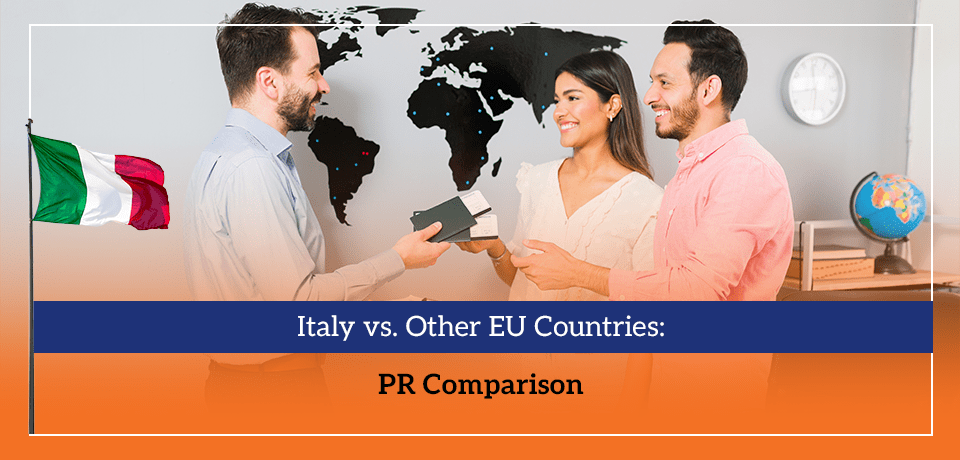
Wondering how to get PR in Italy after study? You're not alone. Italy offers amazing culture, great schools, and a perfect spot in Europe. That's why so many students want to stay long-term.
Great news for you - the Italian government has made it easier for graduates like you to become permanent residents. Here’s a complete guide for you about the whole process of Italy PR after graduation.
Want the most common way to stay? Change your student visa to a work permit. You'll need:
You must apply within 60 days after finishing your degree. Don't miss this deadline! This starts your Italy PR after graduation journey.
Are you more of an entrepreneur? Italy lets you stay through the self-employment visa option. For this path, you'll need:
Partita IVA freelancers in Italy enjoy freedom while working toward permanent residency. This works great if you're a digital nomad, consultant, or creative professional.
The Italian job seeker visa gives graduates time to find a job without leaving the country. It offers:
This path has faster processing and less paperwork for qualified people, especially those with advanced Italian degrees. The Italy Talent Visa is for highly skilled workers in key fields:

After graduation, you have several choices:
The key period is 60 days after finishing your degree. At this time, you must get a new permit or prepare to leave Italy.
Finding work is vital for most Italian immigrants after their studies. The Italian Ministry of Labour's 2025 Skills Shortage List shows these high-demand fields:
Making connections through university job offices (ufficio placement), job fairs (fiere del lavoro), and professional groups helps graduates find jobs.
The Permesso di Soggiorno (temporary residence permit) is the foundation for long-term residency. To apply:
This permit needs renewal every 1-2 years, depending on your situation. Renewal takes 30-60 days.
Quick Tip: Always apply for renewal at least 60 days before your current permit expires. You can legally work with an expired permit while waiting for renewal, but travelling outside Italy during this time is risky.
After 5 years of legal residence in Italy, you can apply for the Carta di Soggiorno application (permanent residence). According to the Italian Immigration Act, you need:
The Italy PR processing time usually takes 6-8 months, though this varies by region. The Immigration Office in Milan processes applications in about 5.5 months, while Naples may take up to 10 months, according to the Ministry of Interior.
The Decreto Flussi 2025 updates set yearly quotas for non-EU workers entering Italy. Graduates from Italian schools get priority.
However, most international students changing to work permits don't count in these quotas. This exemption is stated in Article 22 of the Immigration Act. This gives the study-to-work path a big advantage.
Certain jobs have shortages in Italy and receive special treatment. High-demand jobs Italy include:
Graduates in these fields are more likely to be exempt from quotas and get faster permit processing.
|
Permit Type |
Eligibility |
Benefits |
Limitations |
|
Subordinate Work |
Job offers from Italian employers |
Simple application |
Tied to one employer |
|
EU Blue Card |
University degree, high salary (at least €48,300 yearly as of 2025) |
European mobility, faster PR path |
Higher income needed |
|
Self-Employment |
Business plan, enough funding (minimum €50,000 investment) |
Independence, freedom |
Higher money requirements |
The EU Blue Card Italy benefits include faster permanent residency (possible after 3 years instead of 5) and easier movement within the European Union. According to the Italian Immigration Portal (2025), EU Blue Card holders can bring family members with simpler procedures than standard work permit holders.

The Italian language test for PR requires at least a B1 level on the European language scale. What does B1 mean? It shows you can:
You can get your language certificate from testing centres like the University for Foreigners in Perugia or Siena.
Many Italian cities want to help you fit in. They offer free or low-cost programs, including:
Being financially self-sufficient is key for permanent residency. The 2025 thresholds for the Italian tax for permanent residents qualification are:
Complete health coverage is required for all residency applicants. Options include:
To enrol in the national health service, you need:
Sometimes, Italy's bureaucracy can really be slow. Processing times in Italy are much longer than in other EU countries. Frustrating, right?
Here's how you can handle these delays:
You'll face some competition in the Italian job market. The National Institute of Statistics shows that foreign graduates have an 8% higher unemployment rate than Italians. Don't worry, though! You can stand out.
Try these winning strategies:

Italy's PR processing time (6-8 months) is longer than Germany's (4-6 months) but similar to France's (6-9 months) and shorter than Spain's (8-12 months).
Italy's financial requirements are lower than those of most comparable EU countries:
|
Country |
Single Applicant |
Family of Four |
|
Italy |
€8,500 per year |
€14,000 per year |
|
Germany |
€11,208 per year (€934 per month) |
€22,992 per year (€1,916 per month) |
|
France |
€14,400 per year (€1,200 per month) |
€26,400 per year (€2,200 per month) |
|
Spain |
€28,800 per year (€2,400 per month) |
€43,200 per year (€3,600 per month) |
These lower thresholds make Italy especially attractive compared to countries like Denmark's straightforward PR process for graduates, though requirements vary across the EU, for young professionals and entrepreneurs earlier in their careers.
|
Country |
Residency Requirement |
Language Level |
Job Requirement |
Special Fast Tracks |
|
Italy |
5 years of legal residence |
A2 Italian |
Not required for PR application |
EU Blue Card holders may have facilitated pathways |
|
5 years of residence; 33 months for EU Blue Card holders, reduced to 21 months with B1 German proficiency |
B1 German |
Required for most pathways |
STEM professionals and entrepreneurs may have expedited routes |
|
|
France |
A2 French |
Not strictly required |
Talent Passport holders may have accelerated routes |
|
|
Spain |
5 years of legal residence; 2 years for nationals of Latin American countries, Andorra, the Philippines, Equatorial Guinea, Portugal, or Sephardic communities |
DELE A2 Spanish required for citizenship |
Not required for PR application |
Investors (e.g., €500,000 in real estate) may have expedited pathways |
To help navigate the Italian immigration system, here are essential terms you'll encounter:

The minimum residence requirement is 5 years. However, EU Blue Card Italy holders can qualify after just 3 years. Those married to Italian citizens may get faster processing.
Yes, through the Italy job seeker visa 2025, which gives 12 months to find employment. You can also use self-employment paths or further education to stay legal while establishing longer-term options.
Yes, a minimum B1 level certificate is required for permanent residency applications. The Italian language test for PR must be from an officially recognised testing centre.
Yes, the self-employment visa in Italy leads to permanent residence if you meet income requirements. Those considering international creative careers might also explore prestigious music programs in Canada while evaluating long-term residency options.
Yes, family reunification Italy PR provisions allow spouses of work permit holders to work without needing separate authorisation after processing the initial permit.
Italy tax for permanent residents follows a progressive system ranging from 23% to 43%, depending on income levels. Residents benefit from various deductions and credits that can significantly reduce taxes.
The EU Blue Card Italy benefits include a shorter residency requirement (3 years instead of 5), priority processing, and enhanced mobility within the EU labour market.
Yes, citizenship after PR in Italy is possible after 10 years of legal residence (reduced to 5 years for EU citizens and 3 years for descendants of Italian citizens).
No specific age limit exists for permanent residency applicants. Working-age applicants (18-67) have more straightforward paths through employment-based options.
Rejected applicants may appeal the decision within 60 days through administrative courts. You can also continue maintaining legal status through existing permits while fixing the reasons for rejection.
Want how to get PR in Italy after study? You need to plan ahead. Start at least 6 months before you graduate. Improve your Italian to a B2 level. Make good connections with professionals. Know what paperwork you need. Keep your legal status active at all times.
Even small mistakes can cause big delays. Visit the Ministry of Interior's Sportello Unico website. Get the forms you need. Check for new rules.
This guide helps you move from student to permanent resident. You can make the most of your Italian education with the right steps. Remember Luca's advice: "Start today, not tomorrow." Your Italian dream can become a reality!

December 13 2025

December 06 2025

November 29 2025
Author: Dr Mohammad Shafiq
As a university graduate, you have the theoretical knowledge, but what about the practice? This is why many students start asking, “can you... Read More
Author: Dr Mohammad Shafiq
Are you trying to figure out which are the best universities to study marketing in UK for 2026? If so, you are in the right place. This guide lays out... Read More
Author: Dr Mohammad Shafiq
For most applicants, the planning for UCAS (the central system for applying to UK universities) begins months before the cycle opens. With 2025 deadli... Read More